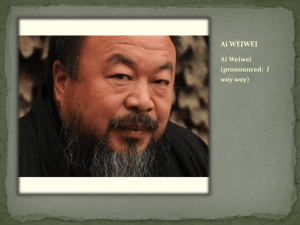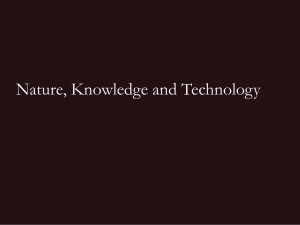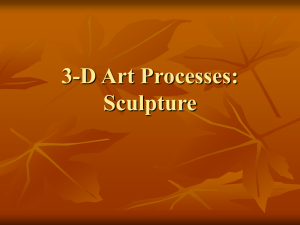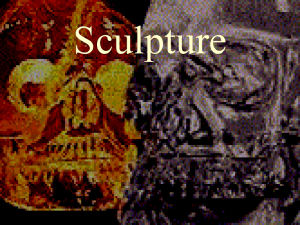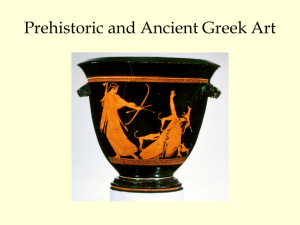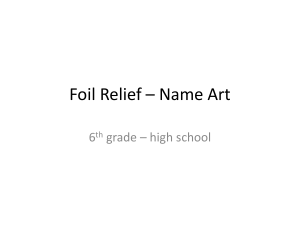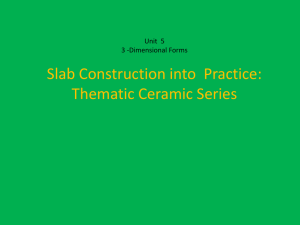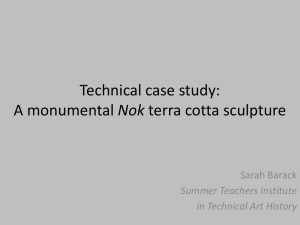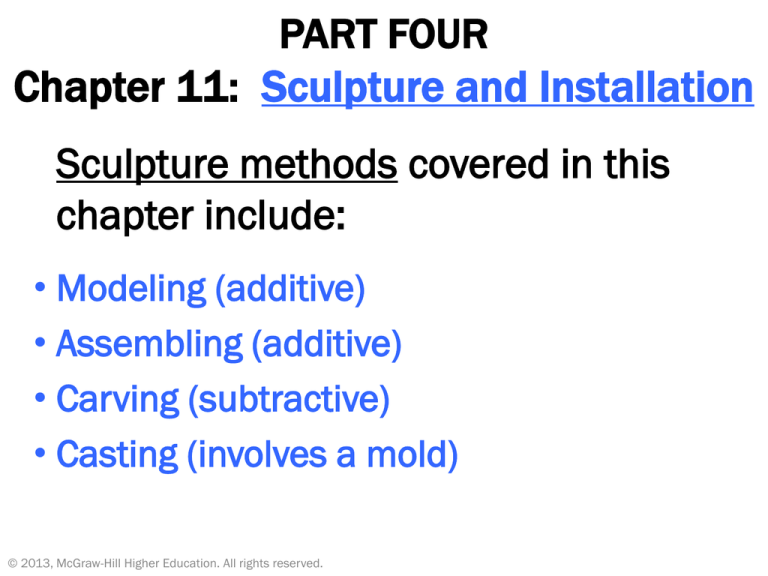
PART FOUR
Chapter 11: Sculpture and Installation
Sculpture methods covered in this
chapter include:
• Modeling (additive)
• Assembling (additive)
• Carving (subtractive)
• Casting (involves a mold)
© 2013, McGraw-Hill Higher Education. All rights reserved.
Key Terms for this chapter include:
• terra cotta
• mold
• lost-wax process
• “in the round”
• low relief (bas-relief)
• high relief
© 2013, McGraw-Hill Higher Education. All rights reserved.
• contrapposto
• installation
• earthwork
• time-based work
Sculpture and Installation
Sculpture involves works of art dealing
with three-dimensional space.
Three-dimensional involves:
Height, Width, and Depth
“In the round”: Freestanding artwork that can
be viewed from any angle; completed on all
sides.
© 2013, McGraw-Hill Higher Education. All rights reserved.
Maman, Louise Bourgeois, 1999,
bronze cast
Sculpture
In relief, forms project from but
remain attached to a background
surface; meant to be viewed frontally.
• Low Relief: Also called bas-relief; figures
project only slightly from the background.
• High Relief: Forms dramatically project
from the background by generally at least
half their depth.
Insert visual(s).
Suggestion: 11.3 Durga Fighting the Buffalo Demon
© 2013, McGraw-Hill Higher Education. All rights reserved.
Low relief (bas-relief) and High
Sarcophagus lid, Mexico, Relief
Mayan late Classical Period
Durga Fighting the Buffalo
Demon, cave, India.
MODELING
Modeling is an additive process. The
sculptor begins with a framework or
nothing at all and adds material until the
sculpture is finished. It is a very direct
method of working.
• Clay, also known as terra cotta, is the
most common modeling material.
Insert visual(s).
Suggestion: 11.4 Figurine of a Voluptuous Lady
© 2013, McGraw-Hill Higher Education. All rights reserved.
Figurine of a Voluptuous Lady,
Maya, 700-900, ceramic
CASTING
Casting is a very indirect method of
working. It involves a mold of some
kind into which liquid or semi liquid
is poured and allowed to harden.
• Bronze is a common casting material.
Insert visual(s).
Suggestion: 11.5 The Bodhisattva Avalokiteshvara
© 2013, McGraw-Hill Higher Education. All rights reserved.
CASTING
The lost-wax process is the most common method
for casting. The wax original is destroyed in the
process making each sculpture cast unique.
© 2013, McGraw-Hill Higher Education. All rights reserved.
Bodhisattva, India, 12thc,
Pala Dynasty
Micael Jackson and Bubbles,
Jeff Koons, 1988, ceramic
Daylight,
Rachel Whiteread, 2010,
Resin.
CARVING
In carving the sculptor begins with a block
of material and cuts, chips, and gouges
away until the form emerges. It is a
subtractive process.
• Wood and stone are the principal
materials historically used for this process.
Insert visual(s).
Suggestion: 11.9 Virgin and Child on the Crescent Moon
© 2013, McGraw-Hill Higher Education. All rights reserved.
Virgin and Child on the
Crescent Moon, 1495,
Limewood
Colossal Head,Olmec,
1500-300, Basalt
ASSEMBLING
In assembling, individual pieces,
segments, or objects are brought
together to form a sculpture. It is an
additive process.
Insert visual(s).
Suggestions:
11.11 Cubi XII
11.13 C.F.A.O.
© 2013, McGraw-Hill Higher Education. All rights reserved.
Cubi XII, 1963, Stainless
Steel, 1963
C.F.A.O., Martin Puryear,
2006-7. Pine and found
wheelbarrow
Conjoined,
Roxy Paine, 2007. Stainless steel and concrete
Sculpture: The Human Figure
The human figure is a basic subject
for sculpture throughout time.
• Contrapposto: Meaning counterpoise
or counterbalance; sets the body in a
gentle S-shaped curve that implies
the potential for human motion.
Insert visual(s).
Suggestion: 11.20 Apoxyomenos (Scraper)
© 2013, McGraw-Hill Higher Education. All rights reserved.
Menkaure and Khamerenebty, Egypt, 24902473 BC
The Burghers of Calais,
Auguste Rodin, 1884-85, Bronze
Kuya Preaching, Kamakura period,
before 1207
Spirit Spouse, Ivory Coast , early 20th
century, wood
Dying Slave, Michelangelo, 1535-16
Apoxyomenos,
(Scraper),Roman copy of
Lyssipos, 320, marble
Contrapossto – slight
weight shift (from Greeks)
Quantum Cloud XX (tornado), Anthony Gormley,
2000, stainless steel
Working with Time and Place
Human beings also sculpt the
landscape and specific environments.
There are practical, religious, and
aesthetic reasons for this type of
sculpture.
Insert visual(s).
Suggestion: 11.25 Serpent Mound
© 2013, McGraw-Hill Higher Education. All rights reserved.
Working with Time and Place
• Earthwork: A work of art made for a
specific place using natural materials
found there, especially the earth
itself.
• Installation: An artist modifies a
space in some way and asks us to
enter, explore, and experience it.
© 2013, McGraw-Hill Higher Education. All rights reserved.
Serpent Mound, near Locust
Grove, OH
Reconstructed Icicles, Andy
Goldsworthy, 1995
Fireflies on the Water, Yayoi Kusama,
2002, 150 lights and water
Red Room, (Child), Louise Bourgeois, Installation, 1994
The Gates,Christo and Jeanne-Claude,
2/12-17/05, Installation in Central Park
Sculpture and Installation: Summary
Sculpture Methods
Modeling
Carving
Assembling
Casting
Key Terms
terra cotta
mold
lost-wax process
“in the round”
low and high relief
© 2013, McGraw-Hill Higher Education. All rights reserved.
contrapposto
installation
earthwork
time-based work

